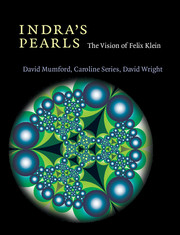Book contents
- Frontmatter
- Contents
- Preface
- Introduction
- 1 The language of symmetry
- 2 A delightful fiction
- 3 Double spirals and Möbius maps
- 4 The Schottky dance pages 96 to 107
- 4 The Schottky dance pages 107 to 120
- 5 Fractal dust and infinite words
- 6 Indra's necklace
- 7 The glowing gasket
- 8 Playing with parameters pages 224 to 244
- 8 Playing with parameters pages 245 to 267
- 9 Accidents will happen pages 268 to 291
- 9 Accidents will happen pages 291 to 296
- 9 Accidents will happen pages 296 to 309
- 10 Between the cracks pages 310 to 320
- 10 Between the cracks pages 320 to 330
- 10 Between the cracks pages 331 to 340
- 10 Between the cracks pages 340 to 345
- 10 Between the cracks pages 345 to 352
- 11 Crossing boundaries pages 353 to 365
- 11 Crossing boundaries 365 to 372
- 12 Epilogue
- Index
- Road map
10 - Between the cracks pages 310 to 320
Published online by Cambridge University Press: 05 January 2014
- Frontmatter
- Contents
- Preface
- Introduction
- 1 The language of symmetry
- 2 A delightful fiction
- 3 Double spirals and Möbius maps
- 4 The Schottky dance pages 96 to 107
- 4 The Schottky dance pages 107 to 120
- 5 Fractal dust and infinite words
- 6 Indra's necklace
- 7 The glowing gasket
- 8 Playing with parameters pages 224 to 244
- 8 Playing with parameters pages 245 to 267
- 9 Accidents will happen pages 268 to 291
- 9 Accidents will happen pages 291 to 296
- 9 Accidents will happen pages 296 to 309
- 10 Between the cracks pages 310 to 320
- 10 Between the cracks pages 320 to 330
- 10 Between the cracks pages 331 to 340
- 10 Between the cracks pages 340 to 345
- 10 Between the cracks pages 345 to 352
- 11 Crossing boundaries pages 353 to 365
- 11 Crossing boundaries 365 to 372
- 12 Epilogue
- Index
- Road map
Summary
‘I thought of a labyrinth of labyrinths, of one sinuous spreading labyrinth that would encompass the past and the future and in some way involve the stars.’
The Garden of Forking Paths, Jorge Luis BorgesIn the last chapter, we investigated a special collection of groups we called ‘accidents’. These were the beautiful double cusp groups in which two symmetries are forced to be parabolic, corresponding to two different rational numbers of our choice. These groups lay right on the borderline between the relatively well-behaved quasifuchsian regime, and the total disorder of non-discreteness. As we are about to see, however, this is not the full tale. There are other yet stranger groups hovering on this same boundary between order and chaos.
Two millennia before the hesitant introduction of imaginary numbers, came the ancient discovery of another class of numbers whose name has acquired over time an even more negative [sic] connotation: irrational numbers, numbers, that is, which cannot be expressed as a ratio p/q. Legend has it that Pythagoras, founder of a religious cult circa 500 BC, discovered that is irrational, and that the revelation was so unnerving the fact was kept secret within the brotherhood. The irrationals lurk in the cracks between the rationals, a kind of invisible glue without which the line would fall apart.
- Type
- Chapter
- Information
- Indra's PearlsThe Vision of Felix Klein, pp. 310 - 320Publisher: Cambridge University PressPrint publication year: 2002

